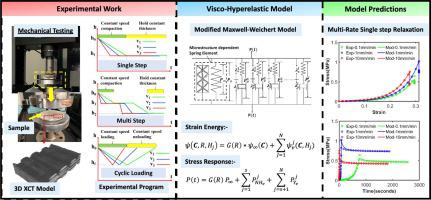Composites Part A: Applied Science and Manufacturing ( IF 8.1 ) Pub Date : 2022-10-08 , DOI: 10.1016/j.compositesa.2022.107229 S. Kulkarni , K.A. Khan , K. Alhammadi , W.J. Cantwell , R. Umer

|
In composites manufacturing processes, such as Liquid Composite Molding (LCM), compaction of a fabric preform is a key processing step. For developing process models of such manufacturing techniques, modelling of the compaction response of the reinforcement is vital. Woven fabrics exhibit a complex viscoelastic compaction response that depends on the architecture and properties of the reinforcement. In this work, we experimentally investigated the rate-dependent response of a 3D orthogonal woven fabric under different loading histories such as, slow-rate compaction, single step compaction, multi-step compaction and cyclic loading tests. A visco-hyperelastic modelling approach was used with a modified Maxwell-Weichert rheological model to describe the viscoelastic compaction behaviour of the 3D woven fabric. The rheological model consists of microstructure-dependent spring elements and Maxwell elements arranged in parallel. The microstructure-dependent spring element accounts for the non-linear rate dependent equilibrium behaviour of the fabric and is described by modified Gutowski’s compaction model. Hyperelastic strain energy functions, such as, Yeoh and NeoHookean, were used to describe the stress response in each Maxwell element. A nonlinear evolution law was adopted to derive an expression for the dissipation rate and deformation in the dashpots of each Maxwell element. The identification of the visco-hyperelastic material parameters was performed and validated against the experimental data.
中文翻译:

一种粘超弹性方法来模拟 3D 机织物的速率相关压实响应
在复合材料制造过程中,例如液体复合材料成型 (LCM),织物预成型件的压实是一个关键的加工步骤。为了开发这种制造技术的过程模型,钢筋的压实响应建模至关重要。机织织物表现出复杂的粘弹性压实响应,这取决于增强材料的结构和特性。在这项工作中,我们通过实验研究了 3D 正交机织物在不同加载历史下的速率相关响应,例如慢速压实、单步压实、多步压实和循环加载测试。粘弹性建模方法与改进的 Maxwell-Weichert 流变模型一起使用,以描述 3D 机织织物的粘弹性压实行为。流变模型由与微观结构相关的弹簧元件和平行排列的麦克斯韦元件组成。与微观结构相关的弹簧元件解释了织物的非线性速率相关平衡行为,并通过修改后的 Gutowski 的压实模型进行了描述。超弹性应变能函数,例如 Yeoh 和 NeoHookean,用于描述每个 Maxwell 单元中的应力响应。采用非线性演化定律推导出每个麦克斯韦单元阻尼器的耗散率和变形表达式。对粘超弹性材料参数进行了识别,并根据实验数据进行了验证。与微观结构相关的弹簧元件解释了织物的非线性速率相关平衡行为,并通过修改后的 Gutowski 的压实模型进行了描述。超弹性应变能函数,例如 Yeoh 和 NeoHookean,用于描述每个 Maxwell 单元中的应力响应。采用非线性演化定律推导出每个麦克斯韦单元阻尼器的耗散率和变形表达式。对粘超弹性材料参数进行了识别,并根据实验数据进行了验证。与微观结构相关的弹簧元件解释了织物的非线性速率相关平衡行为,并通过修改后的 Gutowski 的压实模型进行了描述。超弹性应变能函数,例如 Yeoh 和 NeoHookean,用于描述每个 Maxwell 单元中的应力响应。采用非线性演化定律推导出每个麦克斯韦单元阻尼器的耗散率和变形表达式。对粘超弹性材料参数进行了识别,并根据实验数据进行了验证。采用非线性演化定律推导出每个麦克斯韦单元阻尼器的耗散率和变形表达式。对粘超弹性材料参数进行了识别,并根据实验数据进行了验证。采用非线性演化定律推导出每个麦克斯韦单元阻尼器的耗散率和变形表达式。对粘超弹性材料参数进行了识别,并根据实验数据进行了验证。















































 京公网安备 11010802027423号
京公网安备 11010802027423号